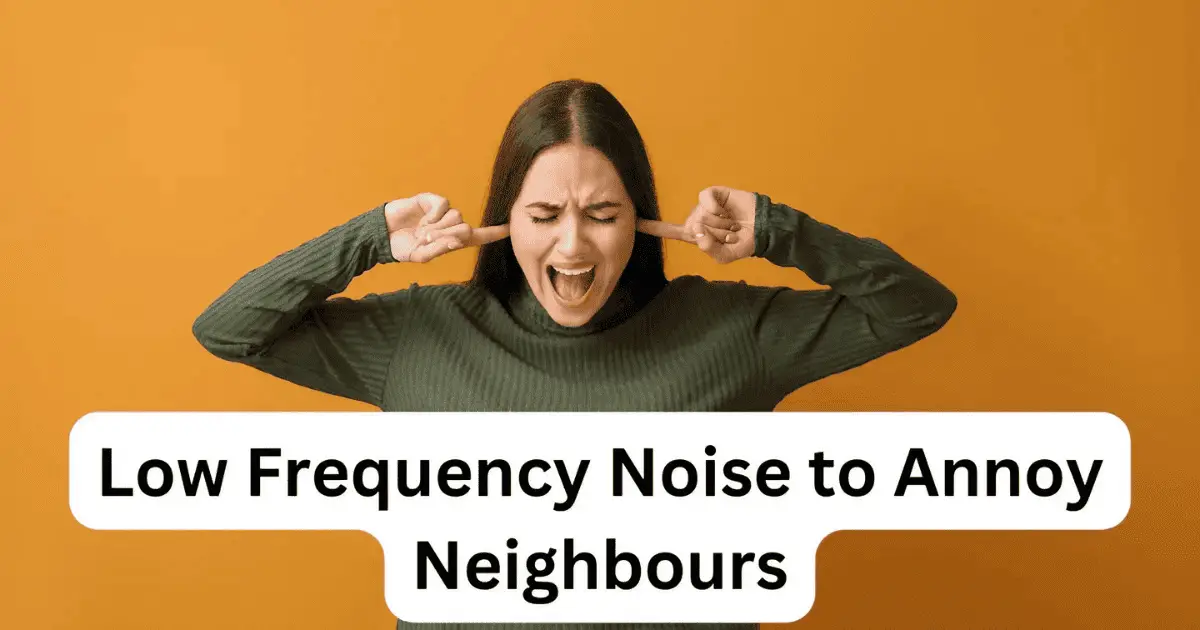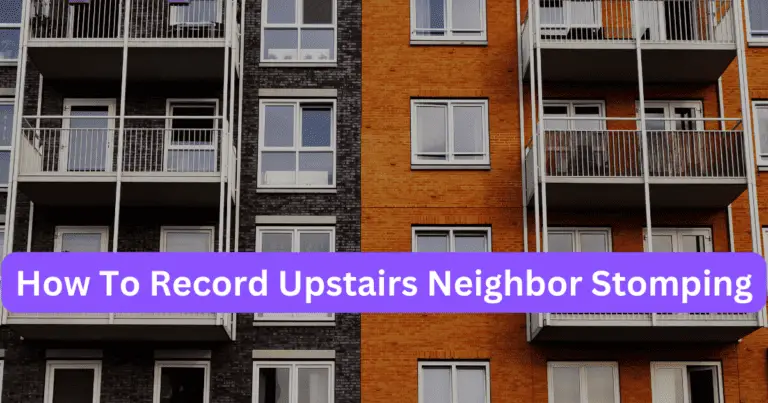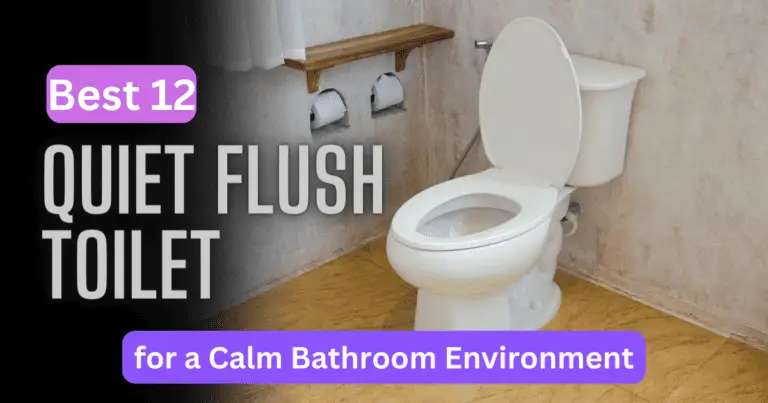14+ Best Low Frequency Noise to Annoy Neighbours

Are you searching for effective ways to deal with noisy neighbors? Frustrated by the noise that is constantly coming, from their apartment? You might find the solution you need in low-frequency noise (LFN).
Low-frequency noise (LFN) is the term used to describe sound waves with frequencies below 200 Hz, They frequently can get over obstacles and disturb people nearby.
According to a report from the NCBI makes you sick.
Living close to neighbors can frequently result in unwelcome noise disruptions. The ongoing disturbance, which can include loud music, rowdy parties, or merely a lot of footfall, can be annoying.
Low-Frequency Noise (LFN) is a category of noise with a frequency below 200 Hz that is more permeable to barriers like walls than higher-frequency sounds.
You can use low-frequency noise to balance out the noise from your neighbors and bring some peace back into your home.
Some people irritate their neighbors by using subwoofers. You can hear music coming from these gadgets without knowing where it came from.
In this article, This article will cover the idea of low-frequency noise, its applications, frequently asked questions about employing gadgets to irritate neighbors, and practical strategies for handling loud neighbors.
So, let’s get started.
What is Low-Frequency Noise?
Sounds with low, rumbling tones that have a frequency under 200 Hz are referred to as low-frequency noise.
Think of the bass notes in your favorite songs—the ones that make your body vibrate. Those sounds have a low frequency! Low-frequency noise is present in our daily life just, as it is in music.
Consider a powerful audio system with subwoofers as an example. Low-frequency noise is what you hear when the volume is turned up and you hear thunderous vibrations.
It can also be heard in places with heavy machinery, like factories or building sites. Low-frequency noise can be produced by even the humming of massive passing automobiles.
The next time the floor vibrates or, rumbling sounds, you’ll know you’re experiencing low-frequency noise.
Why Do You Annoy Neighbours
In California, David lived in a noisy apartment complex. Her cries for calm were ignored by her loud neighbors despite her best efforts.
She stumbled into low-frequency noise generators when she was exhausted and in need of a change. She placed an intriguing order for one and was astounded by its efficiency.
The machine’s calming reproduction of rainforest noises took the place of her neighbors’ grating loudness. Her neighbors were aware of the effect of their noise and changed their conduct when they heard the tranquil hum.
David experienced a fresh sense of gratitude for her neighbors and at last experienced serenity in her house.
Low-frequency noise options offer a way to address noise disturbances while promoting harmony and understanding among neighbors.
By employing such techniques, you can make your home a calm place to live and improve, your connections with others.
Keep in mind that the objective is to strike a balance that ensures everyone can live in peace, not to purposefully irritate neighbors.
READ MORE: How to Soundproof French Doors: 8 Tips and Tricks
Can I use devices to annoy neighbors?
Think of living in a harmonious community where relations are good. Warm grins are exchanged as greetings, and tranquility permeates the atmosphere.
Unfortunately, not every neighborhood is this way.
READ MORE: How To Record Upstairs Neighbor Stomping: 10 Easy Steps
The encouragement of moral conduct and consideration for others is crucial. Low-frequency noise that is intentionally used to bother neighbors is not only rude, but it can also be a form of harassment. It is crucial to put others’ privacy and peace of mind first.
The matter must be approached with caution and consideration for others. Relationships can suffer, and causing unneeded disturbances can have legal repercussions. Consider other ways to resolve the situation before using low-frequency noise or any other technique, like direct conversation, mediation, or, if required, involving relevant authorities. Finding the correct balance between your desire for peace and your neighbors’ rights is essential.
Ethical Considerations: Approach your neighbors politely and without being confrontational if you are having noise issues with them. You can work together to develop a win-win solution by diplomatically addressing the problem.
Promoting Peaceful Coexistence: Consider strategies to promote peaceful cohabitation rather than ways to annoy your neighbors. This entails being upfront and honest with your neighbors, respecting their property lines, and being considerate of noise levels in the early morning or late at night.
Respecting Boundaries: It is not advisable and may have unfavorable effects to use devices to irritate your neighbors. While noise machines can be used to muffle undesirable noises, it’s important to take your neighbors’ homes and environments into account.
Legal Consequences: It’s important to keep in mind that sound levels in residential areas are frequently governed by laws and regulations, making exceeding these limitations of noise generation impossible. It may lead to legal problems and difficult relations with your neighbors if you act in a way that is against these rules.
In conclusion, it is never a good idea to purposefully make low-frequency noise to upset neighbors. We should work to create a calm, pleasant environment where everyone feels secure and at home as responsible members of the community. Let’s work together to create positive connections and discover strategies for peaceful coexistence.
READ MORE: Top 10 Ways To Deal With Loud Upstairs Neighbors
Benefits of Low-Frequency Noise

There are various advantages to retaliating with low-frequency noise.
First of all, it gives you a way to deal with the noise problem subtly, which can support a tranquil home environment.
Second, because low-frequency noise may pass through walls, it can be used to disturb neighbors. It also gives you a sense of control over, the circumstance and can be a temporary fix until a more long-term resolution is reached.
Low-Frequency Devises to Annoy Neighbors
Now that we are familiar, with the basics of low-frequency noise. We’ll explore some of the best options for annoying your neighbors.
Keep in mind that the goal is to find a subversive solution to the noise issue and to persuade your neighbors to be more respectful rather than aggravate the matter. The following 14+ options for low-frequency noise can assist you in doing that:
1. Bass-Heavy Music

Playing music with lots of bass is one of the easiest ways, to disturb your neighbors with low-frequency noise. Turn up the volume and select music with powerful bass lines.
Your neighbors will have a bad listening experience because of the music’s low-frequency vibrations, which will pass through the walls.
Make sure to listen to music styles like dubstep electronic, or hip-hop that feature a lot of bass.
How to Use Bass-Heavy Music?
Your bass-heavy speakers should be connected, to your preferred audio device, such as a laptop or phone.
Use the speakers to project calming music or background noise with pronounced bass frequencies. To balance out the noise from your neighbors, turn up the level to your preference.
2. White Noise Machines
Devices that produce white noise produce a constant sound across all frequencies. They can be useful for blocking out bothersome noises and keeping your neighbors calm.
To irritate your neighbors without being too visible, place a white noise machine close to the shared wall. Find the white noise frequency that annoys them the most by experimenting with various white noise settings.
How to Use a White Noise Machine?
Put the white noise generator close to the wall or other shared space where you want to irritate your neighbors.
To produce a constant sound across all frequencies, turn on the equipment.
Find the white noise frequency that aggravates your neighbors the most by adjusting the volume and experimenting with different white noise settings.
Allow the machine to produce a steady hum that discreetly annoys your neighbors and effectively muffles outside noises.
3. Subwoofers
Speakers known as subwoofers excel at producing low-frequency sounds.
You may create strong bass vibrations that will penetrate the walls and annoy your neighbors by attaching a subwoofer to your audio system.
pick songs or soundtracks with lots of bass. To prevent legal problems or additional disputes, be aware of the time of day and how long you use the subwoofer.
How to Use Subwoofers?
Your audio system, such as a stereo or home theater setup, should be connected to the subwoofer. Play noises or music with a focus on low-frequency tones.
To maximize the deep and relaxing sounds while limiting outside noise, adjust the subwoofer settings to get the ideal bass response.
4. Bass Shakers
Bass shakers are instruments that can be fastened to floors or furniture to produce vibrations. To irritate your neighbors, these vibrations can be independently regulated or timed to music.
Place bass shakers on furniture like bookcases, chairs, or the floor that is directly adjacent to the shared wall.
To strike the ideal balance between irritation and subtlety, change the vibrations’ strength.
How to Use Bass Shakers?
Put bass shakers on the ground or furniture close to the common wall. Connect them to an audio device that produces music or low-frequency sounds. To strike the ideal balance between irritation and subtlety, change the vibrations’ strength. Your neighbors will experience the vibrations as they pass through the surfaces, which will be inconvenient for them.
5. Vibrating Alarm Clocks
Vibrating alarm clocks can be an excellent choice if you want to disturb your neighbors while they are sleeping.
Low-frequency vibrations are used by these alarm clocks to get you up, but they can also annoy people in the area.
The vibrating alarm clock should be placed thoughtfully near the communal wall. Set the alarm to sound at inconvenient times for your neighbors so they may witness the inconvenience firsthand.
How to Use Vibrating Alarm Clocks?
A vibrating alarm clock should be placed close to the communal wall. Set the alarm to go off at times that will inconvenience your neighbors.
They will be annoyed and their sleep will be disturbed by the low-frequency vibrations. Use this strategy to interrupt their sleep and force them to feel the irritation.
6. Thunderstorm Soundtracks
Some people can feel relaxed by listening to nature sounds, including thunderstorms. They may, however, irritate some people if played at low frequencies.
Look for thunderstorm soundtracks that focus on the low-frequency components and play them at a medium volume.
Your neighbors will become uncomfortable as a result of the low rumbling noises in addition to being irritated by them.
How to Use Thunderstorm Soundtracks?
Look for music for thunderstorms that emphasizes low-frequency components. Play the soundtracks close to the shared wall at a moderate volume.
Your neighbors will not only be irritated by the thunderous noises, but they will also feel uneasy. When you wish to induce disquiet and discomfort, choose this option.
7. Industrial Machinery Sounds
Using recordings of noisy industrial equipment can be a good method to irritate your neighbors. These noises can easily pass through walls and are distinguished by their low-frequency components.
Find recordings of large machinery, such as factory or construction equipment, and play them at a volume that is audible but not excessively loud.
Your neighbors will experience annoyance from the constant hum of machines.
How to Use Industrial Machinery Sound?
Find recordings of the noises made by industries or construction machinery. Play the recordings at a volume that is audible but not excessive.
Industrial machinery’s low-frequency hum will easily pass through the walls and bother your neighbors. When you wish to create a troublesome environment, choose this option.
8. Nature Sounds
You can also use natural sounds to irritate your neighbors, such as the sound of the ocean or a jungle.
Choose recordings with low-frequency components and play them loud enough to be heard through the walls.
These noises’ repetitiveness can rapidly grow annoying, giving your neighbors a persistent source of discomfort.
How to Use Nature Sounds?
Choose recordings of nature’s low-frequency sounds, such as ocean waves or jungle noises. Play the recordings loud enough to be heard through the walls.
The low-frequency and repeated natural noises will rapidly grow to grate, giving your neighbors a constant source of discomfort.
9. Sound Dampening Bumpers
Bumpers that absorb sound can be affixed to furniture or other items that vibrate or make low-frequency noise using adhesive pads or strips. These bumpers assist in minimizing the transfer of noise to your neighbors’ homes by lessening the impact of vibrations.
How to use Sound Dampening Bumpers?
Identify furniture or objects that tend to produce vibrations and low-frequency noise. Clean and dry the surface of the furniture or object where the bumper will be attached.
Peel off the backing of the sound-dampening bumper and firmly press it onto the surface. Ensure proper coverage of the areas that come into contact with the floor or walls to effectively reduce vibrations and noise transmission.
10. Dogs Barking Sound Machine
A low-frequency sound generator can play the barking of dogs and other obnoxious animal sounds.
It is possible to program this device to randomly play these obnoxious noises, which makes it hard to enjoy any peace or quiet within the home.
How to use a Dogs Barking Sound Machine?
Obtain a low-frequency sound machine that plays animal noises, such as dog barking. To turn the device on, either plug it into, an outlet or use batteries.
Position the device so that it is directed away from your neighbor’s home. Set the volume so that it will annoy your neighbor while not disturbing anyone else who might be nearby or on an adjacent property.
Please arrange it to play a variety of annoying animal sounds, such as dogs barking and cats meowing at random intervals, intermittently throughout the day and night as desired.
11. High-Pitched Sirens
Your neighbors’ peace may be disturbed by the piercing, attention-grabbing noises produced by high-pitched sirens. To create aggravation and discomfort, place loud sirens close to walls or windows that face your neighbors’ properties.
How to use High-Pitched Sirens?
Place the loud sirens close to walls or windows that face your neighbors’ property. Turn on the sirens to start making the loud noises.
Set the volume so that it is audible and bothersome without being overly disruptive. To change the frequency and length of the sirens, think about utilizing intermittent mode or a timer.
12. Ceiling Vibrator or Thumper
A device called a ceiling vibrator, sometimes known as a thumper, vibrates the ceiling in an annoying, low-frequency manner that may be heard in the living area above. Install a ceiling vibrator or thumper to provide indirect noise disturbance to your neighbors.
How to install a Ceiling Vibrator or Thumper?
Decide where on your ceiling the vibrator or thumper installation will be most effective. Verify that the ceiling’s structural integrity can support the weight of the gadget.
The ceiling vibrator or thumper should be mounted and secured by the manufacturer’s instructions.
To get the required level of disturbance, check the device’s functionality and make the necessary settings adjustments.
13. Noise Generator
A noise generator is a tool that creates various sounds, including low-frequency noise, to cover up undesirable noise or irritate nearby neighbors. Set the noise generator’s parameters to create the ideal soundscape and place it close to any windows or walls that face your neighbors’ property.
How to use a Noise Generator?
Position the noise generator near windows or walls facing your neighbors’ property. Select the desired sound profile or noise type on the device.
Adjust the volume and tone settings to create a pleasant or annoying noise environment. Experiment with different sound options to find the most effective combination for minimizing neighbor noise or inducing annoyance.
14. Automated Super-Loud Buzzer
A powerful audio equipment that produces incredibly loud and attention-grabbing sounds is called an automated super-loud buzzer. In order to disturb and upset your neighbors, place the buzzer close to windows or walls that face their property.
How to use an Automated Super-Loud Buzzer?
Place the automatic, extremely loud buzzer close to any walls or windows that face your neighbors’ property. You can program the device to turn on at particular periods or intervals.
Turn to increase the volume till it is obtrusively loud and disruptive. If you want the buzzer to be more annoying, consider configuring it to emit different tones and patterns.
15. Diesel Engines Recordings
Diesel engine recordings can serve as a potent low-frequency noise source to irritate your neighbors.
These recordings, which can be played at a volume that disturbs your neighbors, capture the deep rumbling sounds made by diesel engines.
Their calm will be disturbed, and their living conditions will become uncomfortable, due to the persistent low-frequency vibrations.
How to use Diesel Engines Recordings Sound?
Find recordings of diesel engines in operation and crank them up loud enough to annoy your neighbors.
Diesel engines emit a substantial amount of low-frequency noise, which is audible in their deep rumbling roar.
Their calm will be disturbed, and their living conditions will become uncomfortable, due to the persistent low-frequency vibrations.
What Is the Best Way to Quiet Loud Neighbors?
While it’s important to handle noise disturbances from neighbors with consideration, here are a few general tips on addressing the issue:
- Communication: Speak politely and amicably with your neighbors about the noise problem. A respectful discussion can assist fix the issue because they might not be aware of how upsetting their actions are.
- Establish Quiet Hours: Propose peaceful times that both parties can enjoy when there is silence. This could contribute to everyone’s ability to live in harmony.
- Earplugs: Invest in high-quality earplugs to reduce, the impact of noise disruptions while you sleep or concentrate on critical work.
- Soundproofing: You can lessen the noise transfer from your neighbors, by using soundproofing materials in your home.
- Involve Authorities: You might need to contact the local authorities or the property management if the noise problems continue and become a serious problem.
Remember that empathy and understanding are crucial when approaching, the situation. You and your neighbors should strive for a peaceful, resolution that respects their needs and well-being.
FAQ: Low Frequency Noise to Annoy Neighbours
It might be difficult to live next to a noisy neighbor, but by using the best low-frequency noise alternatives, you can take back control of your surroundings and discover the calm you deserve.
There are several techniques to reduce noise disruptions and make a peaceful environment, from soundproofing materials to white noise machines, bass-heavy speakers to natural sounds.
Try out these possibilities while keeping in mind, how important it is to have positive connections with your neighbors.
You can manage the problem of neighbor noise more skillfully and take advantage of a quieter living environment by doing this.
Q1. Can low-frequency noise really help reduce neighbor noise?
Ans: Yes, low-frequency noise may effectively equalize and cover up your neighbors’ noise, bringing it to a more tranquil environment.
Q2. How can I use a white noise machine to muffle the sounds of my neighbors?
Ans: Your living space should have a white noise machine with a volume that is comfortable. Your neighbors’ noise may be hidden by the persistent background noise.
Q3. How can soundproofing materials help reduce neighbor noise?
Ans: In order to successfully reduce neighbor noise, soundproofing materials like insulation, panels, and curtains can absorb low-frequency sounds and reduce their transmission.






